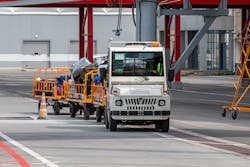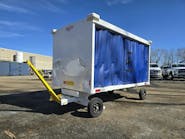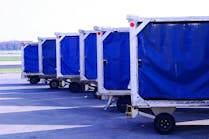Baggage Handling Challenges Demand New Solutions
The demand for air travel in 2022 far exceeded the aviation industry’s expectations and the trend has continued in 2023. The industry estimated that 3.42 billion passengers traveled in 2022.
While that is a positive development, it has not been without its challenges. Most notably, the persistent labor shortages in conjunction with increasing demand have caused many airlines to cancel flights to the disappointment of passengers.
Another area that has been of great concern to airlines, airports, ground handlers and passengers is mishandled passenger baggage, which increases with high demand.
The U.S. Office of Aviation Consumer Protection reported that between January and April of 2022, there was an average rate of delayed bags of 6.4 bags per 1,000 bags enplaned, compared to 3.9 bags over the same period in 2021. SITA reported even higher numbers, noting that in 2022, there were 7.6 mishandled bags per thousand passengers or a total of 2.6 million, almost double that of the prior year.
The problem is particularly pronounced when connecting flights are involved. In fact, SITA noted that transfer bags represented the majority of mishandled bags in 2022.
There are many reasons for these mishaps, but fortunately, there are also new technologies that are effectively helping to mitigate them. Understanding the state of mishandled bags, how the industry is responding and the advanced technologies being implemented is important for all stakeholders.
The Facts on Mishandled Baggage
Baggage handling is affected by many factors including: the efficiency of airlines, airports and ground handlers; baggage handling systems; baggage quantities and sizes; baggage tagging; security and customs checks; check-times and connection times; peak travel seasons; air traffic congestion; weather conditions; and the type of flight (i.e., domestic, international, connecting). Baggage handling policies and procedures vary among airlines. For example, some airlines rely primarily on automated processes whereas others use manual processes.
The waiting times allotted for connecting flights to allow for bags to be transferred from an airport’s baggage station to the connecting flight aircraft also varies. Further, whether passengers have to collect their bags and recheck them depends on each airline’s policy, each nation’s regulations relating to whether or not a passenger has to collect their own baggage and go through customs on the first point of entry. This happens regardless of whether it is the final destination, as well as whether a through-ticket was purchased in which case the passenger typically would not have to get their bags for the transfer, or if the travels involved flights booked on separate tickets or with different airlines. In those instances, a passenger might have to collect their bags and recheck them for the next flight.
Also influencing how efficient baggage handling operations are is the technology used to support effective operations. While there are many systems in place for baggage handling, a big problem lies in the lack of shared, real-time data between the airports, airlines and ground handlers.
The larger the airport, the greater the baggage handling problems that ensue. While some automated baggage technologies and self-serve options can be helpful, they do not address the broader problems with mishandled baggage. What does is optimization software that provides valuable data and decision-making support.
The Baggage Transfer Journey
At its arrival parking position, baggage is unloaded from the aircraft, separating local baggage and transfer baggage. The local baggage is transported to the baggage reclaim belts if no stop at customs is required.
Transfer baggage is either driven to the baggage sorting facility where it is forwarded to the baggage belts or chutes of their connecting flight. Or, for the more time critical connections, a tail-to-tail transfer directly to the connecting flight can be required. For loose loaded aircraft, the tail-to-tail bags can be directly collected while unloading, whereas for containerized aircraft, the matching ULD must be identified and opened to collect the bags.
In addition to involving multiple steps, these tail-to-tail baggage transfers are work intensive compared to other baggage handling processes, because deliveries have to be made to individual aircraft stands rather than delivering them to the closest baggage induction point. Given labor shortages, as well as staff absences due to illness, vacation, etc., there are often too few employees on hand for these tasks, which may prompt ground handlers to deliver less bags tail-to-tail. This, in effect, increases the number of misconnected bags. To optimize these processes, baggage handling optimization software becomes vital.
Baggage Handling Optimization Software
Advanced baggage handling optimization software takes a more holistic approach towards improving these processes. It tackles the problem of mishandled or lost baggage by providing critical information pertaining to passengers and their baggage connections in advance so that any potential problems can be resolved prior to an aircraft’s landing. The software evaluates high priority flights and passenger connections in conjunction with key performance indicators (KPIs), cost to benefit ratios, and passenger notification.
The goal is to avoid preventable disruptions. It automatically updates information from flight information systems, booking systems, and flight departure control systems. All staff involved in baggage transfers from dispatchers to drivers are supported along with such tasks as the dispatch of agents for short and missed connections. Dashboard updates and other reports deliver valuable data relating to support optimal decision-making and operational efficiency.
Where transfer baggage is concerned, the software maximizes the possible tail-to-tail baggage transfers, taking into account all available resources and the current workload. Baggage managers can set a time corridor for the so-called cut-off time, which determines up to which connection time bags will be transported tail-to-tail. The software automatically maximizes the tail-to-tail connections within the given time corridor. This advanced functionality is already being tested by leading airlines.
Benefits Derived
Advanced baggage handling optimization software with the latest functionality to optimize transfer baggage processes benefits all stakeholders.
Airlines benefit from the real-time analysis of critical connections and detection of potential disruptions, and the ability to provide a better passenger experience due to fewer missed connections and mishandled baggage. Employees involved in baggage realize reduced workloads, increased productivity and greater job satisfaction. Further, the costs associated with mishandled baggage are reduced substantially. Airport Industry News reported that mishandled baggage between flight connections and the over 4 million bags mishandled during transfer, cost the industry $2.2 billion in 2022 alone.
The leading baggage handling and transfer optimization software solutions feature user-friendly design and flexible architecture. Some are enhanced with graphical, self-refreshing overviews and color-coded connection data. Sophisticated connection time engines facilitate critical details, giving consideration to factors such as walking distance, bus/terminal transfers, passenger profiles, checkpoints, and peak hour congestion. Options for decision support may include instructing direct transfers, assessing alternate parking positions, sending additional staff, and rebooking choices.
Also taken into consideration are the cost of a delay compared to a rebooking cost. Such digital solutions enable staff to remain informed through their mobile devices.
The value in applying optimization software to improve all baggage handling including transfer baggage processes has not been lost on the airlines. SITA reported that real-time baggage status information is a key priority for them as evidenced by this finding: 57 percent of airlines are providing their staff with mobile access to real-time baggage status information; a percentage projected to increase to 84 percent by 2025.
Some 67 percent of airlines also plan to make baggage status information available to passengers, up from the current 25 percent.
The future of baggage handling optimization is bright and hopefully, mishandled baggage will be more of an anomaly than a regular occurrence.
Michael Reinkober is product manager for GS RealTime Staff and Equipment at INFORM GmbH, a leading global provider of intelligent optimization solutions for airlines, airports, and ground handlers.






